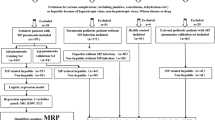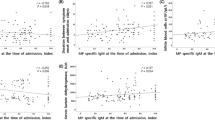Abstract
Objective
To investigate the clinical characteristics and risk factors for pneumonia in children co-infected with influenza A virus (IAV) and Mycoplasma pneumoniae (MP).
Methods
Children who were diagnosed with IAV and MP infection between January and December, 2023 were enrolled and divided into a non-pneumonia group and a pneumonia group. Univariate analysis and logistic regression analysis were used to evaluate each index, and the risk factors for pneumonia caused by coinfection in the two groups were explored.
Results
A total of 209 patients were enrolled, of which 107 and 102 patients were in the pneumonia and non-pneumonia groups, respectively. The patients in the pneumonia group were older and had a longer duration of fever (P < 0.05). Univariate analysis revealed that the median age, duration of fever, and CD3+, CD4+, CD8+ and IL-10 levels were significantly correlated with pneumonia (P < 0.05). Multivariate logistic regression analysis revealed that the median age, duration of fever, and CD4+, CD8+ and IL-10 levels were independent risk factors for pneumonia. Area under the curve of the five combined indicators in the ROC (receiver operator characteristic) analysis was 0.883, was higher than single factor.
Conclusion
Children with IAV and MP infection whose age older than 6.08 years, had a fever longer than 4 days, had a CD4+ count < 22.12%, had a CD8+ count < 35.21%, had an IL-10 concentration > 22.08 ng/ml were more likely to develop pneumonia.


Similar content being viewed by others
Data Availability
The datasets generated during and/or analysed during the current study are not publicly available due to privacy requirements but are available from the corresponding author on reasonable request.
References
Liu B et al (2016) The C-terminal tail of TRIM56 dictates antiviral restriction of influenza A and B viruses by impeding viral RNA synthesis. J Virol 90(9):4369–4382
LeMessurier KS et al (2020) Influenza A virus directly modulates mouse eosinophil responses. J Leukoc Biol 108(1):151–168
Le Goffic R et al (2007) Cutting edge: Influenza A virus activates TLR3-dependent inflammatory and RIG-I-dependent antiviral responses in human lung epithelial cells. J Immunol 178(6):3368–3372
Shen Y et al (2012) TRIM56 is an essential component of the TLR3 antiviral signaling pathway. J Biol Chem 287(43):36404–36413
Liu BM et al (2024) Key roles for phosphorylation and the Coiled-coil domain in TRIM56-mediated positive regulation of TLR3-TRIF-dependent innate immunity. J Biol Chem 300(5):107249
Hu Q et al (2023) Risk factors for death associated with severe influenza in children and the impact of the COVID-19 pandemic on clinical characteristics. Front Pediatr 11:1249058
Trusinska D. et al. (2024) Risk factors for poor outcomes in children hospitalized with virus-associated acute lower respiratory infections: a systematic review and meta-analysis. Pediatr Infect Dis J 2024 May 1;43(5):467–476
Mingyue J, Luzhao F (2023) Consideration on the usage of full-dose influenza vaccine for the infants aged 6–35 months old. Chin J Prev Med 57(2):281–285
Huang H, Wu B, Lin W (2024) Characterising respiratory infections among hospitalised children during the COVID-19 pandemic in southeastern China: a cross-sectional study of pathogens and clinical association. BMJ Open 14(1):e076824
Chengbo Z, Wenbo L (2022) Analysis of non-bacterial respiratory pathogens in children in Ningbo City from 2019 to 2021. Chin J Prev Med 56(12):1751–1758
Sakleshpur S, Steed AL (2022) Influenza: Toward understanding the immune response in the young. Front Pediatr 10:953150
Control, E.C.f.D.P.a. Acute respiratory infections in the EU/EEA: epidemiological update and current public health recommendations. Infectious disease topics 2023; Available from: https://www.ecdc.europa.eu/en/news-events/acute-respiratory-infections-eueea-epidemiological-update-and-current-public-health
Looi MK (2023) China: Rising cases of respiratory disease and pneumonia spark WHO concern. BMJ 383:2770
Parums DV (2023) Editorial: Outbreaks of post-pandemic childhood pneumonia and the re-emergence of endemic respiratory infections. Med Sci Monit 29:e943312
China National Clinical Research Center for Respiratory DiseasesGroup of Respirology C.P.S. and C.M. Association (2020) Expert consensus on diagnosis and treatment of influenza in children (2020 Edition). Chin J Pract Pediatr Clin 35(17):1281–1288
Children’s Medication Group E.C.f.R.D.U (2020) National health and family planning commission, Expert consensus on laboratory diagnostics and clinical practice of Mycoplasma pneumoniae infection in children in China (2019). Chin J Pediatr 58(5):366–373
Subspecialty Group of Respiratory Diseases S.o.P., Chinese Medical Association and E.B.o.C.J.o. Pediatrics (2013) Guidelines for the management of community-acquired pneumonia in children (2013 revision)(Part 1). Chin J Pediatr 51(10):745–752
Frutos AM et al (2024) Interim estimates of 2023–24 seasonal influenza vaccine effectiveness - United States. MMWR Morb Mortal Wkly Rep 73(8):168–174
Abraham C et al (2023) Vaccine mandates and influenza vaccination during the pandemic. Pediatrics 152(5)
Diseases NCRCfR, SGoR Diseases (2020) Pediatric initiative on improving uptake of seasonal influenza vaccination among children during the COVID 一19 pandemic. Chin J Pract Pediatr Clin 35(17):1289–1291
Paniskaki K et al (2023) Increased SARS-CoV-2 reactive low avidity T cells producing inflammatory cytokines in pediatric post-acute COVID-19 sequelae (PASC). Pediatr Allergy Immunol 34(12):e14060
Liu S et al (2013) MCPIP1 restricts HIV infection and is rapidly degraded in activated CD4+ T cells. Proc Natl Acad Sci U S A 110(47):19083–19088
Liu BM et al (2024) Mpox (Monkeypox) Virus and Its Co-infection with HIV, sexually transmitted infections, or bacterial superinfections: Double whammy or a new prime culprit? Viruses 16(5):784
Santiago-Carvalho I et al (2023) T cell-specific P2RX7 favors lung parenchymal CD4(+) T cell accumulation in response to severe lung infections. Cell Rep 42(11):113448
Medzhitov R, Schneider DS, Soares MP (2012) Disease tolerance as a defense strategy. Science 335(6071):936–941
Fang W, Boliang Z (2014) Detection and analysis of peripheral blood T lymphocyte subsets in patients with influenza A (H1N1). Int J Lab Med 7:922–923
Ding L et al (2016) Association of T lymphocyte subsets and allergens with Mycoplasma pneumoniae infection complicated by wheezing in infants and young children. Zhongguo Dang Dai Er Ke Za Zhi 18(12):1254–1258
Liu BM et al (2021) Clinical significance of measuring serum cytokine levels as inflammatory biomarkers in adult and pediatric COVID-19 cases: A review. Cytokine 142:155478
Liu BM, Hill HR (2020) Role of host immune and inflammatory responses in COVID-19 cases with underlying primary immunodeficiency: A review. J Interferon Cytokine Res 40(12):549–554
Liu BM, Beck EM, Fisher MA (2021) The brief case: ventilator-associated corynebacterium accolens pneumonia in a patient with respiratory failure due to COVID-19. J Clin Microbiol 59(9):e0013721
Saraiva M, P Vieira, A O'Garra (2020) Biology and therapeutic potential of interleukin-10. J Exp Med 217(1)
Neumann C, Scheffold A, Rutz S (2019) Functions and regulation of T cell-derived interleukin-10. Semin Immunol 44:101344
Rojas JM et al (2017) IL-10: A multifunctional cytokine in viral infections. J Immunol Res 2017:6104054
Choreño-Parra JA et al (2021) Clinical and immunological factors that distinguish COVID-19 from pandemic influenza A(H1N1). Front Immunol 12:593595
Kim JH et al (2018) Clinical features of Mycoplasma pneumoniae coinfection and need for its testing in influenza pneumonia patients. J Thorac Dis 10(11):6118–6127
Liu B, Forman M, Valsamakis A (2019) Optimization and evaluation of a novel real-time RT-PCR test for detection of parechovirus in cerebrospinal fluid. J Virol Methods 272:113690
Liu B (2017) Universal PCR primers are critical for direct sequencing-based enterovirus genoty**. J Clin Microbiol 55(1):339–340
Liu B et al (2020) Development and evaluation of a fully automated molecular assay targeting the mitochondrial small subunit rRNA gene for the detection of pneumocystis jirovecii in bronchoalveolar lavage fluid specimens. J Mol Diagn 22(12):1482–1493
Liu BM et al (2024) Laboratory diagnosis of CNS infections in children due to emerging and re-emerging neurotropic viruses. Pediatr Res 95(2):543–550
Funding
This work was supported by the Henan Provincial Science and Technology Research Project [grant numbers LHGJ20200620, LHGJ20220734] and by 2023 Open Subjects of Henan Provincial Engineering Research Center for Diagnosis and Treatment of Pediatric Infections and Critical Illnesses [China] [grant number ERC202304].
Author information
Authors and Affiliations
Contributions
All authors contributed to the study conception and design. Material preparation, data collection and analysis were performed by Wanyu Jia, Yangji Wang, and Junhao Cui. The first draft of the manuscript was written by Shuqin Fu. Peng Li and Chunlan Song conceptualized the study and reviewed and edited the manuscript. All authors commented on previous versions of the manuscript. All authors read and approved the final manuscript.
Corresponding author
Ethics declarations
Ethics approval and consent to participate
This study was performed in line with the principles of the Declaration of Helsinki. Approval was granted by the Medical Ethics Committee of Henan Children’s Hospital (approval number: [2022-K-L046]).
Consent to participate
This is a retrospective study, so informed consent was waived.
Competing interests
The authors declare that they have no known competing financial interests or personal relationships that could have influenced the work reported in this paper.
Additional information
Publisher's Note
Springer Nature remains neutral with regard to jurisdictional claims in published maps and institutional affiliations.
Rights and permissions
Springer Nature or its licensor (e.g. a society or other partner) holds exclusive rights to this article under a publishing agreement with the author(s) or other rightsholder(s); author self-archiving of the accepted manuscript version of this article is solely governed by the terms of such publishing agreement and applicable law.
About this article
Cite this article
Fu, S., Jia, W., Li, P. et al. Risk factors for pneumonia among children with coinfection of influenza A virus and Mycoplasma pneumoniae. Eur J Clin Microbiol Infect Dis (2024). https://doi.org/10.1007/s10096-024-04854-3
Received:
Accepted:
Published:
DOI: https://doi.org/10.1007/s10096-024-04854-3




